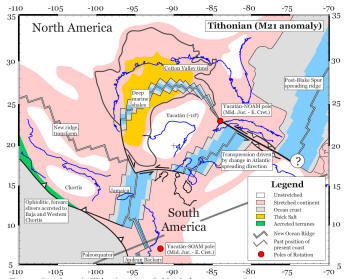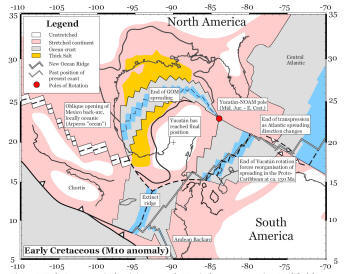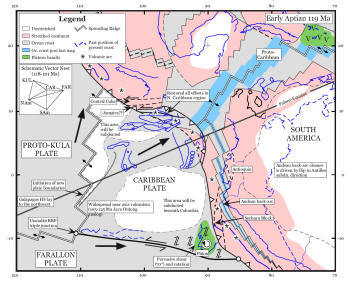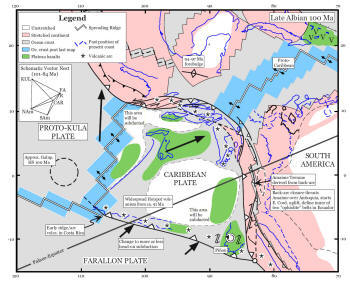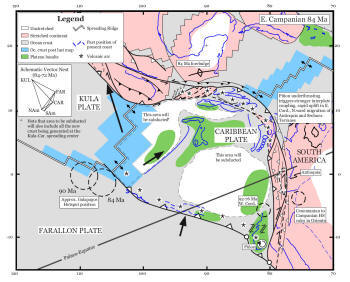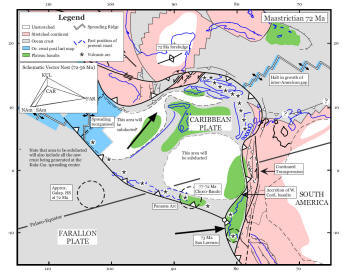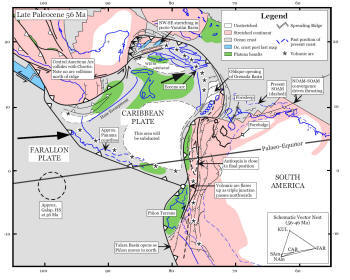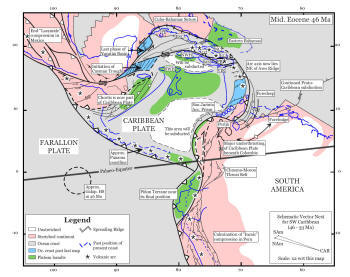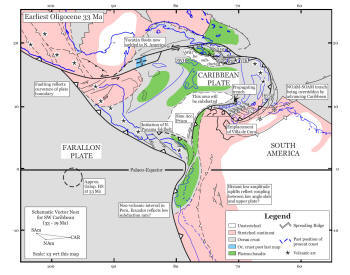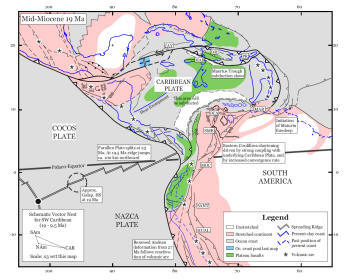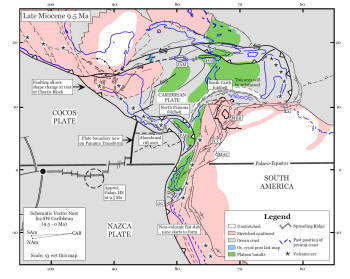The rocks documenting subduction zones in the
Caribbean realm formed during the Lower Cretaceous, Upper Cretaceous and
Tertiary. The information retrieved from these rocks is essential in building
valuable plate-tectonic models for the region, as they document the position and
thermal regimes of subduction zones fringing the plate. But, before the basic
geology and metamorphic petrology of subduction complexes of the region is
evaluated, it is worth considering the plate tectonic models currently proposed.
|
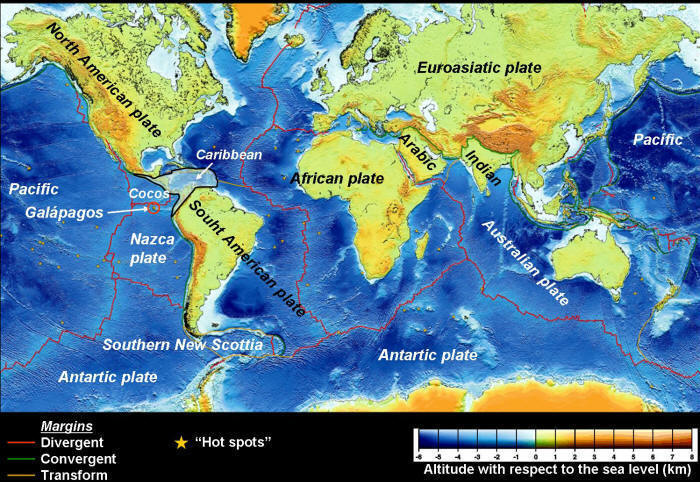
image source:
http://www.ig.utexas.edu/research/projects/plates/pt.info.htm |
The
Caribbean plate occupies a position in between two mayor plates, the North and
South American plates. These two plates are dominated by continental masses.
This fact has controlled part of the lengthy evolution of the Caribbean plate. |
|
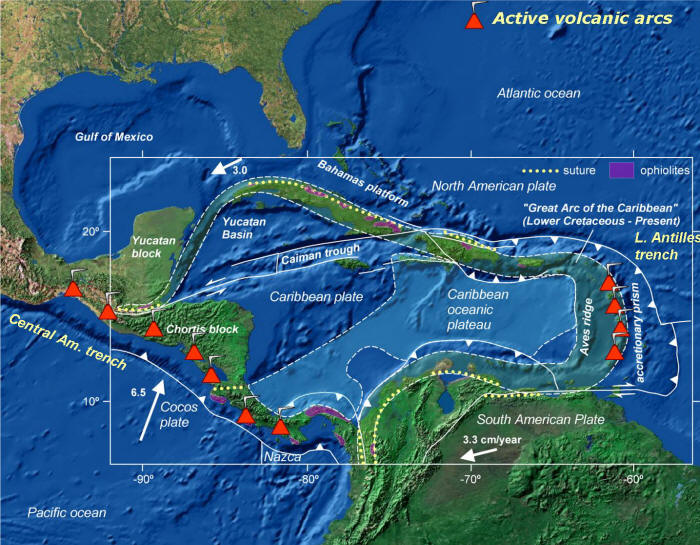
image source:
http://www.geographynetwork.com/ and compilation by
García-Casco
el al. (2006) |
The plate is bounded by two active subduction
zones which have two associated active trenches and volcanic arcs,
the Lesser Antilles (to the East) and the Central American (to the West)
trenches/arcs, and by two complex transform-trascurrent fault zones, the
Motagua-Polochic-Swan-Bartlett/Oriente to the North, and the northern South
American fault system to the South, where subduction of the
Caribbean plate below South America is active at present.
The above mentioned configuration developed
during the Late Eocene/Early Oligocene. Since then, the Yucatan basin (developed
during the latest Cretaceous- Middle Eocene) and the Cuban segment of the peri-Caribbean
orogenic belt are attached to the North American plate. |
|

image source:
http://www.geographynetwork.com/ and compilation by
García-Casco
el al. (2006) |
The peri-Caribbean orogenic belt runs from
Guatemala through the Greater and Lesser Antilles to northern South America. The
belt contains the active volcanic arc of the Lesser Antilles, where the Atlantic subducts below the Caribbean Plate, but it also contains volcanic arc rocks of
Cretaceous to Tertiary age that documents a lengthy history of subduction
associated with the leading edge of the Caribbean plate. Geological and
geopysical data allow locating this volcanic arc and the associated subduction
zone back in time (light thin yellow lines), through the Miocene (M), Oligocene
(O), Eocene (E), Paleocene (P), Upper Cretaceous (UC) and Lower Cretaceous (LC),
when the arc was located at a position similar to that of the present-day
Central American volcanic arc. This indicates that the Caribbean Plate formed at
the Pacific and drifted, relative to the Americas, towards the East during the
Mesozoic and the Tertiary (light thick yellow arrow). During this trip, the
volcanic arc, which has been called the “Great Arc of the Caribbean”, faced and
collided with the continental margins of the Yucatan block, the Bahamas and
South America during the uppermost Cretaceous and Tertiary (light blue curved
arrows). The rocks documenting subduction zones in the peri-Caribbean orogenic
belt formed during the Cretaceous and Tertiary. |
|

Image source: Müller, R.D., Cande, S.C., Royer, J.-Y., Roest, W.R. and
Maschenkov, S., 1999,
New constraints on the Late Cretaceous/Tertiary plate tectonic evolution
of the Caribbean, in: Caribbean Basins.
Sedimentary basins of the world, 4, Ed. P. Mann, Elsevier Science,
Amsterdam, p. 39-55. |
Understanding the evolution of the Caribbean realm needs
understanding the fragmentation of Pangea and formation of oceanic basins in the
region. In short, the following events can be established:
-
240-180 Ma: Pangea drift
-
180-000 Ma: Opening of the North Atlantic
-
180-130 Ma: Opening of the Gulf of Mexico
-
130-000 Ma: Formation of the Caribbean Volcanic Arc
-
130-000 Ma: Opening of the South Atlantic
-
130-000 Ma: Relative eastward motion of the Caribbean plate
-
180-070 Ma: N-S America divergence
-
090-080 Ma: Formation of the Caribbean Oceanic Plateau
-
070-000 Ma: N-S America convergence
-
070-000 Ma: Caribbean Arc-NA/SA collision
-
040-000 Ma: Cayman pull-apart basin
It is apparent that, because the volcanic arc activity started
in the mid-Cretaceous (pre?-Aptian) when NA and SA were drifting away, the
Caribbean arc can hardly be conceptualized as a result of NA-SA convergence.
As a consequence, it follows that an oceanic basin (the
Proto-Caribbean) should have formed in between the Americas during 180-70 Ma,
and that the Caribbean plate must be exotic with respect to its present position
in between the Americas. |
|
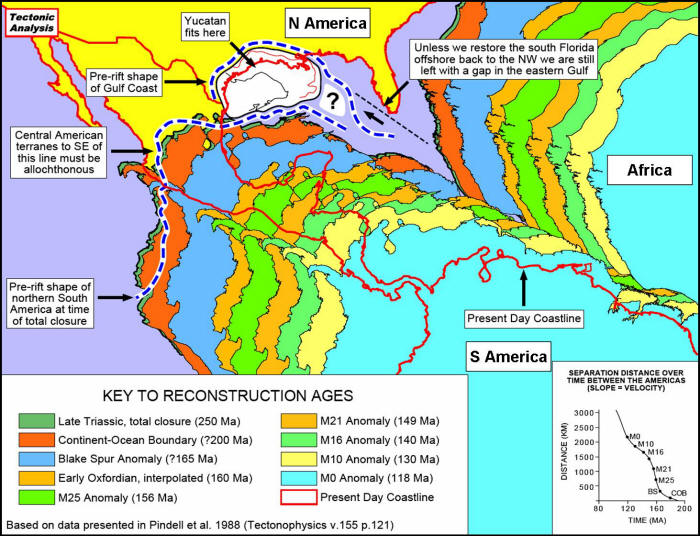
image source:
http://www.tectonicanalysis.com/ |
Reconstruction of the relative motion of South America with
respect to North America.
Mesozoic divergence should have formed an oceanic basin in
between (the Proto-Caribbean). |
|
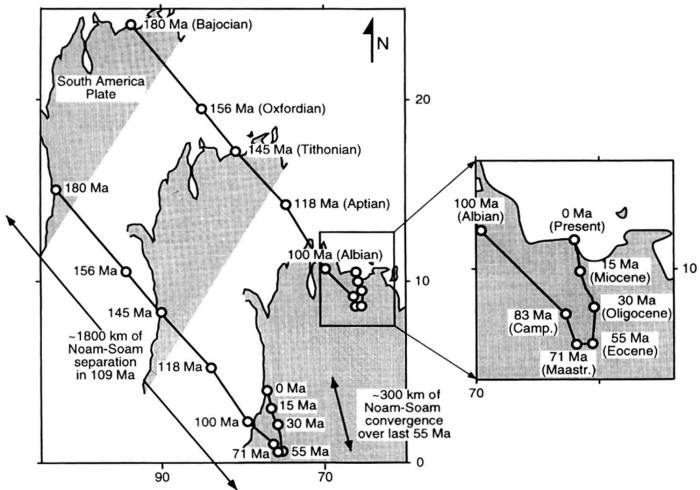
Image source: Mann, P., Caribbean sedimentary basins: Classification and
tectonic setting from Jurassic to Present, Chapter 1 in Caribbean
Basins, 4: Sedimentary Basins of the World, edited by P. Mann, Elsevier,
Amsterdam, 3-31, 1999.
http://www.elsevier.com/wps/find/bookseriesdescription.cws_home/BS_SBW/description?navopenmenu=-2 |
Reconstruction of the relative motion of South America with
respect to North America.
Mesozoic divergence should have formed an oceanic basin (the
Proto-Caribbean) in between the Americas.
The small convergence rate since the Tertiary cannot explain
the development of the Caribbean arc (volcanic activity started at ca. 130 Ma). |
In general, most authors agree in a) formation of an oceanic
inter-Americas gap (i.e., Proto-Caribbean) during Jurassic break-up of Pangea
and Cretaceous drift of North and South America, b) progressive consumption of
the Proto-Caribbean during the Cretaceous-Tertiary in one or several subduction
zones, c) insertion of the Pacific derived Caribbean plate into the
inter-Americas gap and d) collision of the Caribbean plate with the North and
South American plate margins during the uppermost Cretaceous and Tertiary
(Wilson, 1966; Malfait and Dinkelman, 1972; Mattson, 1979; Pindell and Dewey,
1982; Burke et al., 1984; Duncan and Hargraves; 1984; Burke, 1988; Pindell and
Barrett, 1990; Pindell, 1985, 1994; Iturralde-Vinent, 1998; Kerr et al., 1998,
1999; Mann, 1999; Pindell and Kennan, 2001; see complete references in
García-Casco
el al., 2006)). This process may have been accompanied by a change in polarity
of subduction, from eastward-dipping subduction of the Pacific below the
Proto-Caribbean to westward-dipping subduction of the Proto-Caribbean below the
Pacific (Caribbean), but the age and tectonic scenario of the flip is debated.
Burke (1988), Duncan and Hargraves (1984) and Kerr et al.
(1998) have argued for an Upper Cretaceous flip of subduction, while Mattson
(1979), Pindell and Dewey (1982), Pindell (1994) and Pindell and Kennan (2001)
have proposed an Aptian age. Mid-Cretaceous unconformities recorded in volcanic
arc sequences along the Antilles and Venezuela have been related to an important
mid-Cretaceous orogenic event by Pindell and Kennan (2001). Lebron and Perfit
(1993, 1994) argued for a mid-Cretaceous flip based on an abrupt change from IAT
to CA affinity in volcanic arc rocks, but this argument has been disputed by
Kerr et al. (1999), Jolly et al. (2001). Mid-Cretaceous reversal of subduction
has been related to northward overthrusting of the arc by oceanic crust in the
Cordillera Central of Hispaniola (Draper et al., 1996, Lewis et al., 1999,
2002), but according to Lapierre et al. (1997, 1999) this tectonic event took
place in Upper Cretaceous times.
|
A reconstruction by Pindell, J.L. & Kennan, L., (2001.
Kinematic Evolution of the Gulf of Mexico and Caribbean. In: Fillon, R.,
Rosen, N.,Weimer, P., Lowrie, A., Pettingill, H., Phair, R., Roberts,
H., van Hoorn, B. (eds.). Transactions of the Gulf Coast Section Society
of Economic Paleontologists and Mineralogists (GCSSEPM) 21st Annual Bob
F. Perkins Research Conference, Petroleum Systems of Deep-Water Basins,
Houston, Texas, 193-220;
download pdf file; also visit
http://www.tectonicanalysis.com/site/download/default.htm) is given
below. Note that, in this model:
-
Pre-Aptian subduction
involved consumption of the Pacific
-
A flip of subduction
allowing the consumption of the Proto-Caribbean below the Caribbean
plate took place in the Aptian
-
Formation of the
Caribbean plate took place in the Aptian
-
The relative eastward
motion of the Caribbean plate since the Aptian was possible as a
consequence of the consumption of the Proto-Caribbean basin
-
Collision between the
leading edged of the Caribbean and the North and South American
margins (Yucatan, Bahamas, Venezuela-Trinidad) started in the Upper
Cretaceous (Campanian-Maastrichtian) and lasted until present.
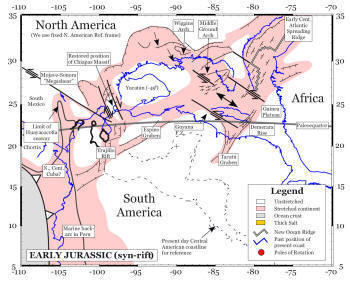 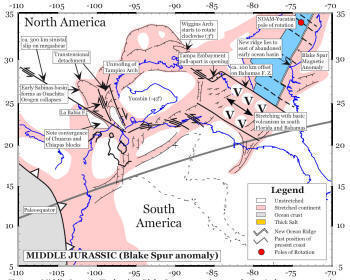  |
The issue of the plate tectonic evolution of the Caribbean is
hot, and studies of subduction-related metamorphic rocks do certainly add to
this debate.
last modified:
01.04.08 23:36 +0100









